Satas D., Tracton A.A. (ed.). Coatings Technology Handbook
Подождите немного. Документ загружается.

This Page Intentionally Left Blank
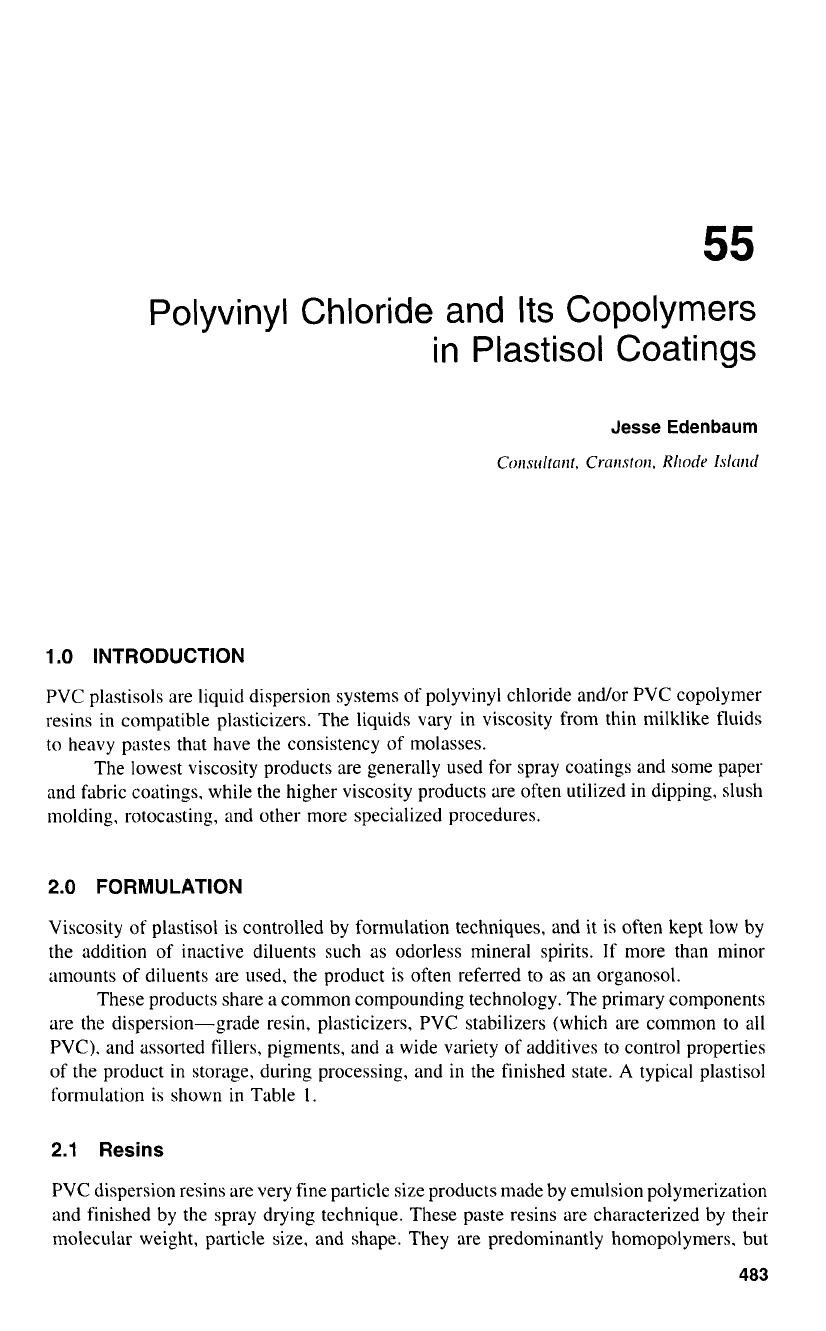
55
Polyvinyl Chloride and
Its
Copolymers
in Plastisol Coatings
1
.O
INTRODUCTION
PVC plastisols are liquid dispersion systems of polyvinyl chloride andor PVC copolymer
resins in compatible plasticizers. The liquids vary in viscosity from thin milklike fluids
to
heavy pastes that have the consistency of molasses.
The lowest viscosity products are generally used for spray coatings and some paper
and fabric coatings. while the higher viscosity products are often utilized in dipping, slush
molding, rotocasting, and other more specialized procedures.
2.0
FORMULATION
Viscosity
of
plastisol is controlled by formulation techniques, and it is often kept low by
the addition of inactive diluents such as odorless mineral spirits.
If
more than minor
amounts of diluents are used, the product is often referred
to
as an organosol.
These products share a common compounding technology. The primary components
are the dispersion-grade resin, plasticizers, PVC stabilizers (which are common to all
PVC). and assorted fillers, pigments, and a wide variety of additives
to
control properties
of the product in storage, during processing, and
in
the finished state.
A
typical plastisol
formulation is shown in Table
1.
2.1
Resins
PVC dispersion resins are very fine particle size products made by emulsion polymerization
and finished by the spray drying technique. These paste resins are characterized by their
molecular weight, particle size, and shape. They are predominantly homopolymers. but
483
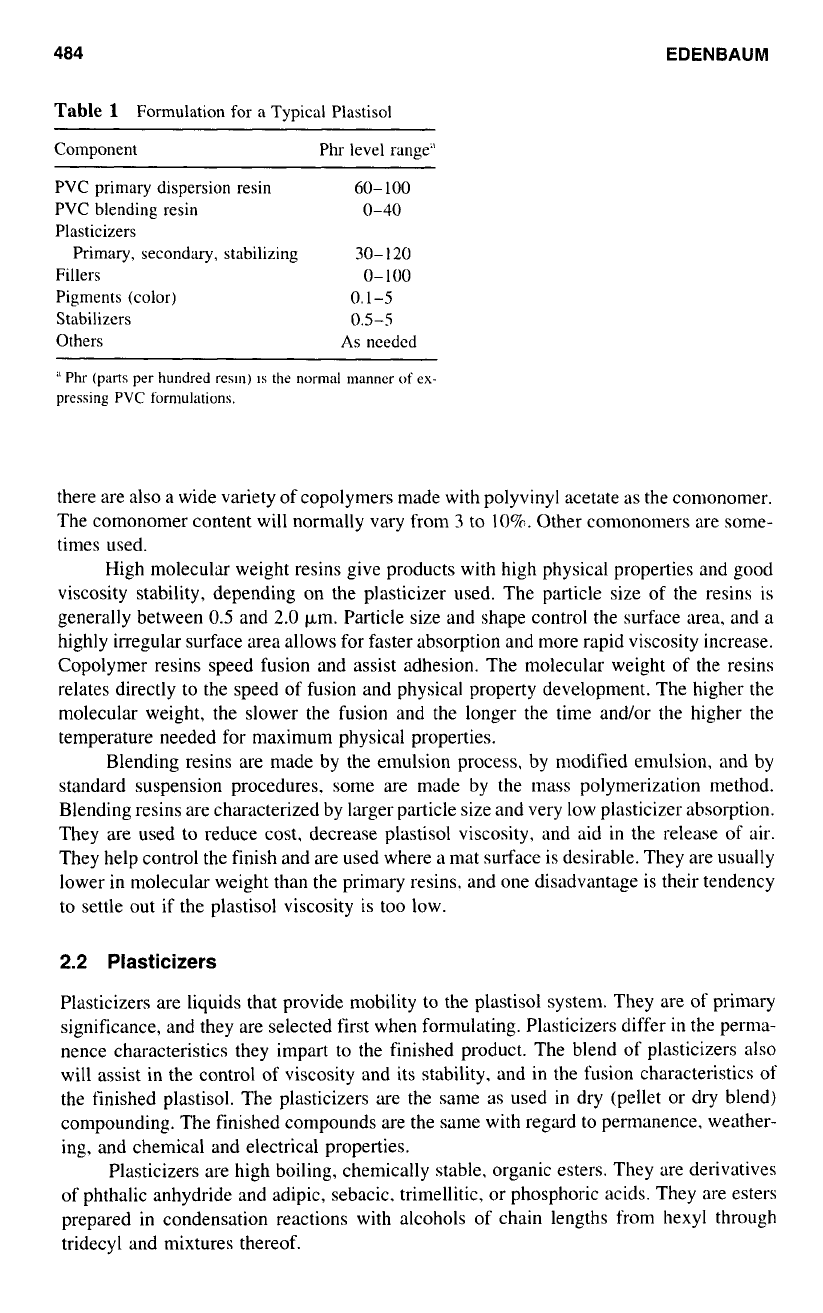
484
EDENBAUM
Table
1
Formulation
for
a Typical Plastisol
Component Phr level range"
PVC primary dispersion resin
60-
100
PVC blending resin
0-40
Plasticizers
Primary, secondary, stabilizing
30-
120
Fillers
0-
100
Pigments (color)
0.1-5
Stabilizers
0.5-5
Others
As
ncedcd
''
Phr
(parts
per
hundred
resln)
IS
the
normal
manner
of
ex-
pressing
PVC
formulations.
there are also
a
wide variety of copolymers made with polyvinyl acetate
as
the comonomer.
The comonomer content will normally vary from
3
to
10%.
Other comonomers are some-
times used.
High molecular weight resins give products with high physical properties and good
viscosity stability, depending on the plasticizer used. The particle size
of
the resins is
generally between
0.5
and
2.0
km.
Particle size and shape control the surface area, and a
highly irregular surface area allows for faster absorption and more rapid viscosity increase.
Copolymer resins speed fusion and assist adhesion. The molecular weight of the resins
relates directly to the speed of fusion and physical property development. The higher the
molecular weight, the slower the fusion and the longer the time and/or the higher the
temperature needed for maximum physical properties.
Blending resins are made by the emulsion process, by modified emulsion, and by
standard suspension procedures. some are made by the
rims
polymerization method.
Blending resins are characterized by larger particle size and very low plasticizer absorption.
They are used
to
reduce cost, decrease plastisol viscosity, and aid
in
the release
of
air.
They help control the finish and are used where
a
mat surface is desirable. They are usually
lower in molecular weight than the primary resins. and one disadvantage is their tendency
to settle out if the plastisol viscosity is too low.
2.2
Plasticizers
Plasticizers are liquids that provide mobility to the plastisol system. They are of primary
significance, and they are selected first when formulating. Plasticizers differ in the perma-
nence characteristics they impart to the finished product. The blend of plasticizers also
will assist in the control
of
viscosity and its stability. and in the fusion characteristics
of
the finished plastisol. The plasticizers are the same as used
in
dry (pellet or dry blend)
compounding. The finished compounds are the same with regard to permanence. weather-
ing, and chemical and electrical properties.
Plasticizers are high boiling, chemically stable. organic esters. They are derivatives
of phthalic anhydride and adipic, sebacic. trimellitic, or phosphoric acids. They are esters
prepared in condensation reactions with alcohols of chain lengths from hexyl through
tridecyl and mixtures thereof.
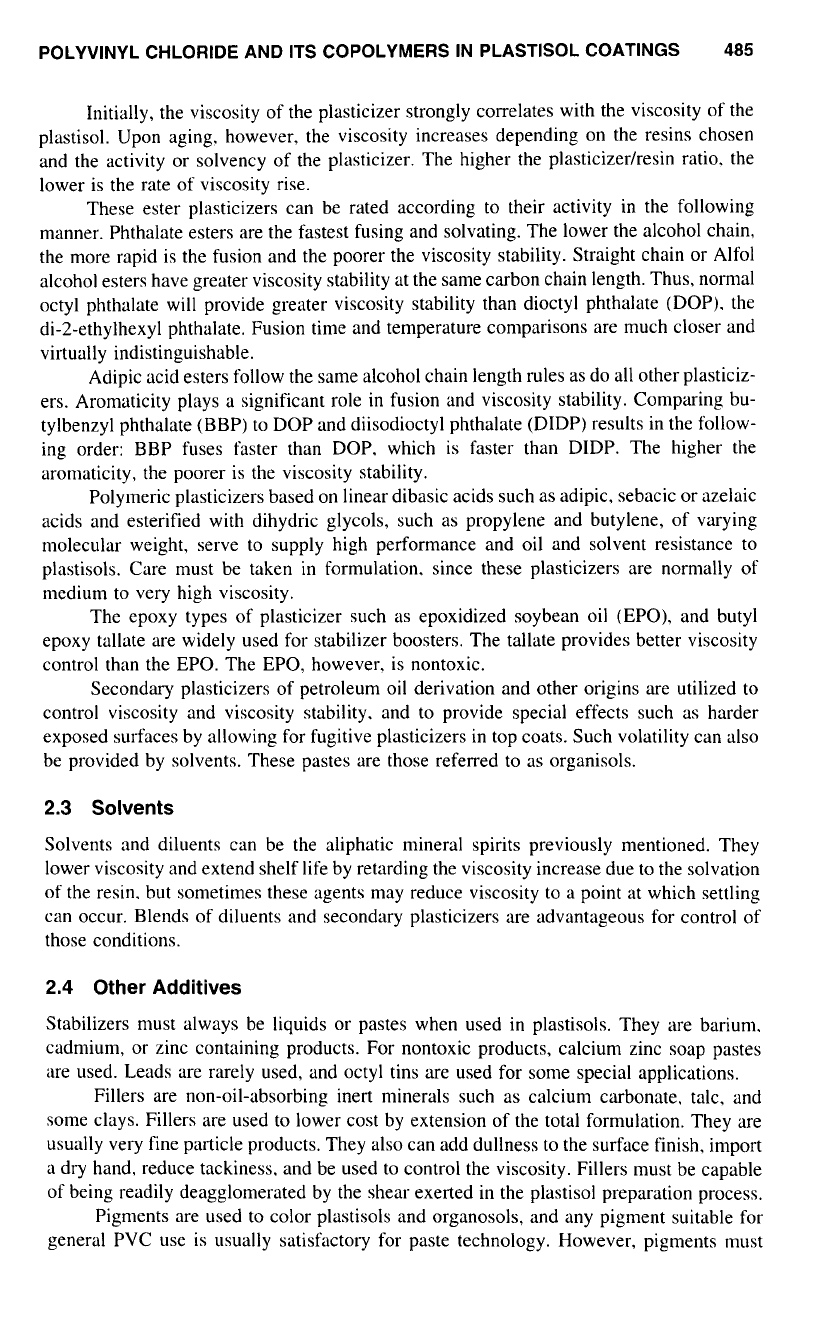
POLYVINYL CHLORIDE AND ITS COPOLYMERS IN PLASTISOL COATINGS
485
Initially, the viscosity of the plasticizer strongly correlates with the viscosity of the
plastisol. Upon aging. however, the viscosity increases depending
on
the resins chosen
and the activity or solvency of the plasticizer. The higher the plasticizer/resin ratio, the
lower is the rate
of
viscosity rise.
These ester plasticizers can be rated according
to
their activity in the following
manner. Phthalate esters are the fastest fusing and solvating. The lower the alcohol chain,
the more rapid is the fusion and the poorer the viscosity stability. Straight chain or Alfol
alcohol esters have greater viscosity stability at the same carbon chain length. Thus, normal
octyl phthalate will provide greater viscosity stability than dioctyl phthalate (DOP). the
di-2-ethylhexyl phthalate. Fusion time and temperature comparisons are much closer and
virtually indistinguishable.
Adipic acid esters follow the same alcohol chain length rules as do all other plasticiz-
ers. Aromaticity plays a significant role in fusion and viscosity stability. Comparing bu-
tylbenzyl phthalate (BBP) to DOP and diisodioctyl phthalate (DIDP) results in the follow-
ing order: BBP fuses faster than DOP, which is faster than DIDP. The higher the
aromaticity, the poorer is the viscosity stability.
Polymeric plasticizers based on linear dibasic acids such as adipic, sebacic or azelaic
acids and esterified with dihydric glycols, such as propylene and butylene,
of
varying
molecular weight, serve to supply high performance and
oil
and solvent resistance to
plastisols. Care must be taken
in
formulation. since these plasticizers are normally
of
medium to very high viscosity.
The epoxy types
of
plasticizer such as epoxidized soybean oil (EPO), and butyl
epoxy tallate are widely used for stabilizer boosters. The tallate provides better viscosity
control than the EPO. The EPO, however. is nontoxic.
Secondary plasticizers of petroleum oil derivation and other origins are utilized
to
control viscosity and viscosity stability. and to provide special effects such as harder
exposed surfaces by allowing for fugitive plasticizers in top coats. Such volatility can also
be provided by solvents. These pastes are those referred to as organisols.
2.3
Solvents
Solvents and diluents can be the aliphatic mineral spirits previously mentioned. They
lower viscosity and extend shelf life by retarding the viscosity increase due to the solvation
of
the resin. but sometimes these agents may reduce viscosity to a point at which settling
can occur. Blends of diluents and secondary plasticizers are advantageous for control of
those conditions.
2.4
Other Additives
Stabilizers must always be liquids or pastes when used in plastisols. They are barium.
cadmium, or zinc containing products. For nontoxic products, calcium zinc soap pastes
are used. Leads are rarely used, and octyl tins are used for some special applications.
Fillers are non-oil-absorbing inert minerals such as calcium carbonate. talc, and
some clays. Fillers are used
to
lower cost by extension of the total formulation. They are
usually very fine particle products. They also can add dullness to the surface finish, import
a dry hand, reduce tackiness. and be used to control the viscosity. Fillers must be capable
of being readily deagglomerated by the shear exerted in the plastisol preparation process.
Pigments are used
to
color plastisols and organosols, and any pigment suitable for
general PVC use is usually satisfactory for paste technology. However, pigments must
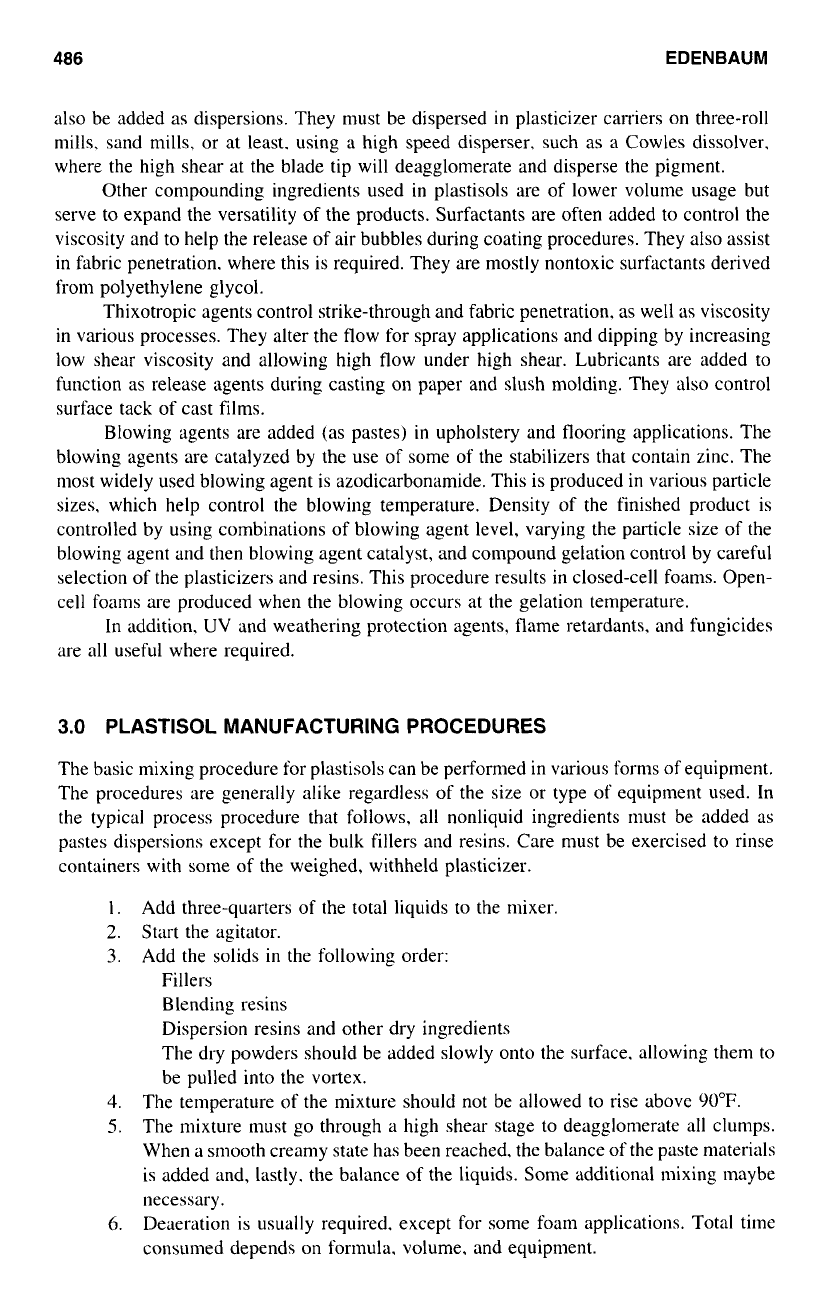
486
EDENBAUM
also be added
as
dispersions. They must be dispersed in plasticizer carriers on three-roll
mills. sand mills, or at least. using
a
high speed disperser, such as
a
Cowles dissolver,
where the high shear at the blade tip will deagglomerate and disperse the pigment.
Other compounding ingredients used
in
plastisols are
of
lower volume usage but
serve to expand the versatility
of
the products. Surfactants are often added
to
control the
viscosity and to help the release of air bubbles during coating procedures. They
also
assist
in
fabric penetration, where this is required. They are mostly nontoxic surfactants derived
from polyethylene glycol.
Thixotropic agents control strike-through and fabric penetration, as well
as
viscosity
in various processes. They alter the flow for spray applications and dipping by increasing
low shear viscosity and allowing high flow under high shear. Lubricants are added to
function
as
release agents during casting
on
paper and slush molding. They
also
control
surface tack of cast films.
Blowing agents are added
(as
pastes)
in
upholstery and flooring applications. The
blowing agents are catalyzed by the use
of
some of the stabilizers that contain zinc. The
most widely used blowing agent is azodicarbonamide. This is produced
in
various particle
sizes. which help control the blowing temperature. Density of the finished product is
controlled by using combinations
of
blowing agent level, varying the particle size of the
blowing agent and then blowing agent catalyst, and compound gelation control by careful
selection
of
the plasticizers and resins. This procedure results in closed-cell foams. Open-
cell foams are produced when the blowing occurs at the gelation temperature.
In addition,
UV
and weathering protection agents, flame retardants. and fungicides
are
all
useful where required.
3.0
PLASTISOL MANUFACTURING PROCEDURES
The basic mixing procedure for plastisols can be performed in various forms of equipment.
The procedures are generally alike regardless of the size or type
of
equipment used. In
the typical process procedure that follows,
all
nonliquid ingredients must be added as
pastes dispersions except for the bulk fillers and resins. Care must be exercised to rinse
containers with some of the weighed, withheld plasticizer.
1.
Add three-quarters
of
the total liquids
to
the mixer.
2.
Start the agitator.
3.
Add the solids
in
the following order:
Fillers
Blending resins
Dispersion resins and other dry ingredients
The dry powders should be added slowly onto the surface. allowing them
to
be pulled into the vortex.
4.
The temperature
of
the mixture should not be allowed
to
rise above
90°F.
S.
The mixture must go through
a
high shear stage to deagglomerate
all
clumps.
When a smooth creamy state has been reached. the balance
of
the paste materials
is added and, lastly. the balance
of
the liquids. Some additional mixing maybe
necessary.
6.
Deaeration is usually required. except for some foam applications. Total time
consumed depends on formula. volume, and equipment.
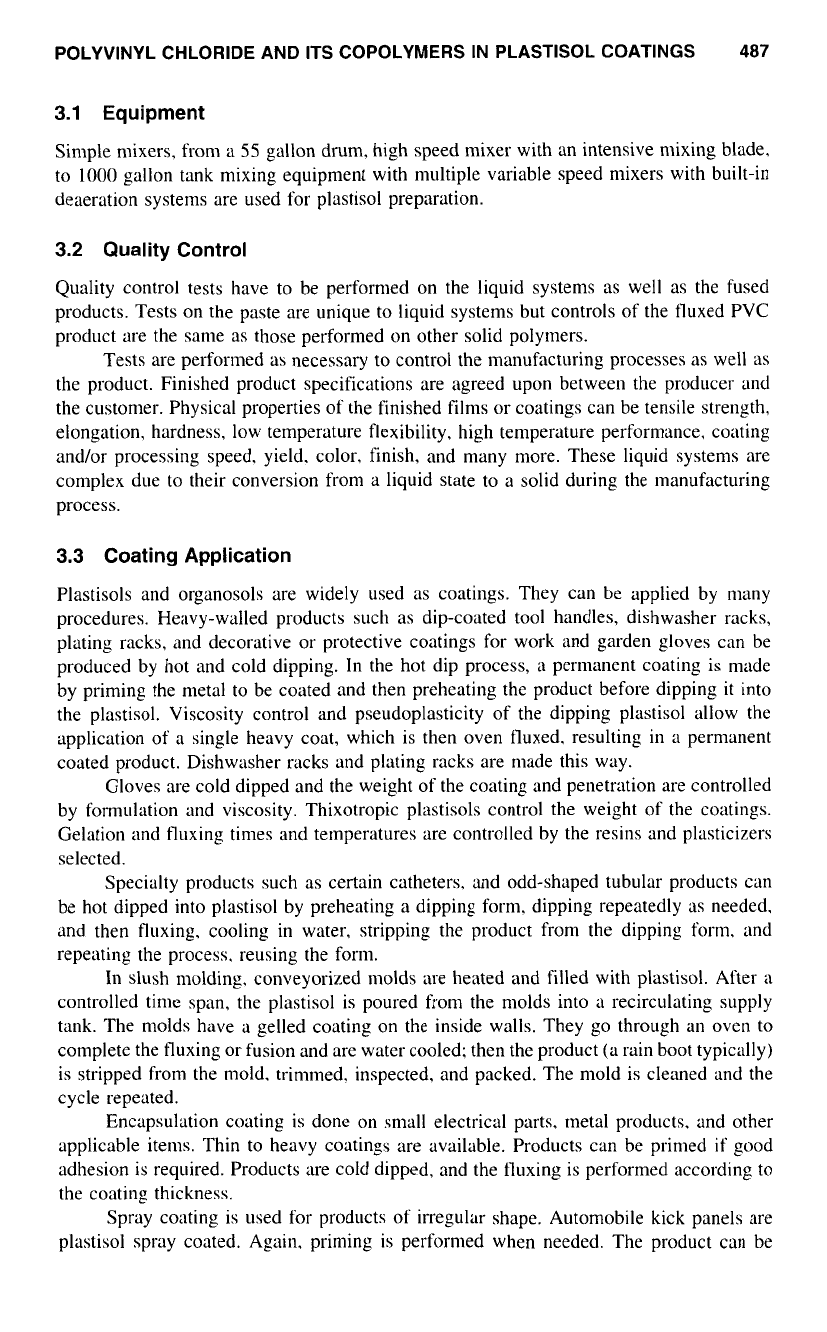
POLYVINYL CHLORIDE AND
ITS
COPOLYMERS IN PLASTISOL COATINGS
487
3.1 Equipment
Simple mixers, from a
55
gallon drum, high speed mixer with an intensive mixing blade.
to
1000
gallon tank mixing equipment with multiple variable speed mixers with built-in
deaeration systems are used for plastisol preparation.
3.2 Quality Control
Quality control tests have to be performed on the liquid systems as well as the fused
products. Tests on the paste are unique
to
liquid systems but controls
of
the tluxed PVC
product are the same as those performed
on
other solid polymers.
Tests are performed as necessary to control the manufacturing processes as well as
the product. Finished product specifications are agreed upon between the producer and
the customer. Physical properties of the finished films or coatings can be tensile strength,
elongation, hardness, low temperature flexibility, high temperature performance. coating
and/or processing speed. yield. color. finish, and many more. These liquid systems are
complex due
to
their conversion from a liquid state to a solid during the manufacturing
process.
3.3
Coating Application
Plastisols and organosols are widely used as coatings. They can be applied by many
procedures. Heavy-walled products such as dip-coated tool handles, dishwasher racks,
plating racks, and decorative or protective coatings for work and garden gloves can be
produced by hot and cold dipping.
In
the hot dip process,
a
permanent coating is made
by priming the metal to be coated and then preheating the product before dipping it into
the plastisol. Viscosity control and pseudoplasticity of the dipping plastisol allow the
application of a single heavy coat, which is then oven fluxed, resulting in
a
permanent
coated product. Dishwasher racks and plating racks are made this way.
Gloves are cold dipped and the weight of the coating and penetration are controlled
by formulation and viscosity. Thixotropic plastisols control the weight of the coatings.
Gelation and fluxing times and temperatures are controlled by the resins and plasticizers
selected.
Specialty products such as certain catheters. and odd-shaped tubular products can
be hot dipped into plastisol by preheating
a
dipping form, dipping repeatedly as needed,
and then fluxing. cooling in water. stripping the product from the dipping form. and
repeating the process, reusing the form.
In slush molding. conveyorized molds are heated and filled with plastisol. After
a
controlled time span, the plastisol is poured from the molds into
a
recirculating supply
tank. The molds have a gelled coating on the inside walls. They go through an oven
to
complete the tluxing or fusion and are water cooled; then the product (a rain boot typically)
is stripped from the mold. trimmed. inspected, and packed. The mold is cleaned and the
cycle repeated.
Encapsulation coating is done on small electrical parts, metal products, and other
applicable items. Thin to heavy coatings are available. Products can be primed
if
good
adhesion
is
required. Products are cold dipped, and the fluxing is performed according
to
the coating thickness.
Spray coating is used for products
of
irregular shape. Automobile kick panels are
plastisol spray coated. Again, priming is performed when needed. The product can be
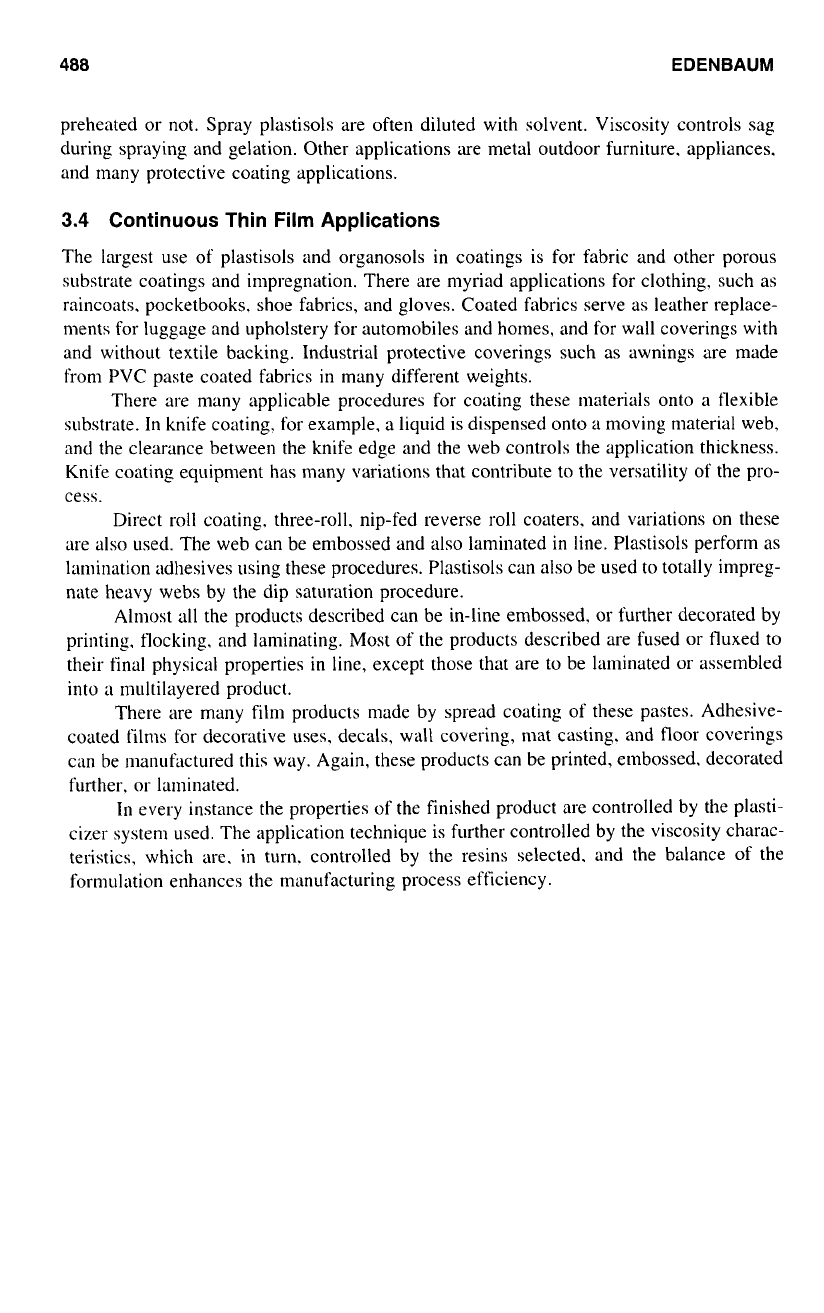
488
EDENBAUM
preheated or
not.
Spray plastisols are often diluted with solvent. Viscosity controls sag
during spraying and gelation. Other applications are metal outdoor furniture, appliances.
and many protective coating applications.
3.4
Continuous Thin Film Applications
The largest use of plastisols and organosols
in
coatings is for fabric and other porous
substrate coatings and impregnation. There are myriad applications for clothing. such as
raincoats. pocketbooks. shoe fabrics, and gloves. Coated fabrics serve
as
leather replace-
ments for luggage and upholstery for automobiles and homes, and for wall coverings with
and without textile backing. Industrial protective coverings such as awnings are made
from PVC paste coated fabrics
in
many different weights.
There are many applicable procedures for coating these materials onto
a
flexible
substrate.
In
knife coating. for example, a liquid is dispensed onto a moving material web,
and the clearance between the knife edge and the web controls the application thickness.
Knife coating equipment has many variations that contribute to the versatility of the pro-
cess.
Direct roll coating. three-roll, nip-fed reverse
roll
coaters. and variations on these
are also used. The web can be embossed and
also
laminated
in
line. Plastisols perform as
lamination adhesives using these procedures. Plastisols can also be used to totally impreg-
nate heavy webs by the dip saturation procedure.
Almost all the products described can be in-line embossed. or further decorated by
printing. flocking. and laminating. Most
of
the products described are fused or fluxed to
their final physical properties in line, except those that are to be laminated or assembled
into
a
multilayered product.
There are many film products made by spread coating
of
these pastes. Adhesive-
coated films for decorative uses. decals.
wall
covering, mat casting. and
floor
coverings
can be manufactured this way. Again, these products can be printed, embossed. decorated
further. or laminated.
111
every instance the properties
of
the finished product are controlled by the plasti-
cizer system used. The application technique is further controlled by the viscosity charac-
teristics. which are. in turn. controlled by the resins selected. and the balance
of
the
formulation enhances the manufacturing process efficiency.
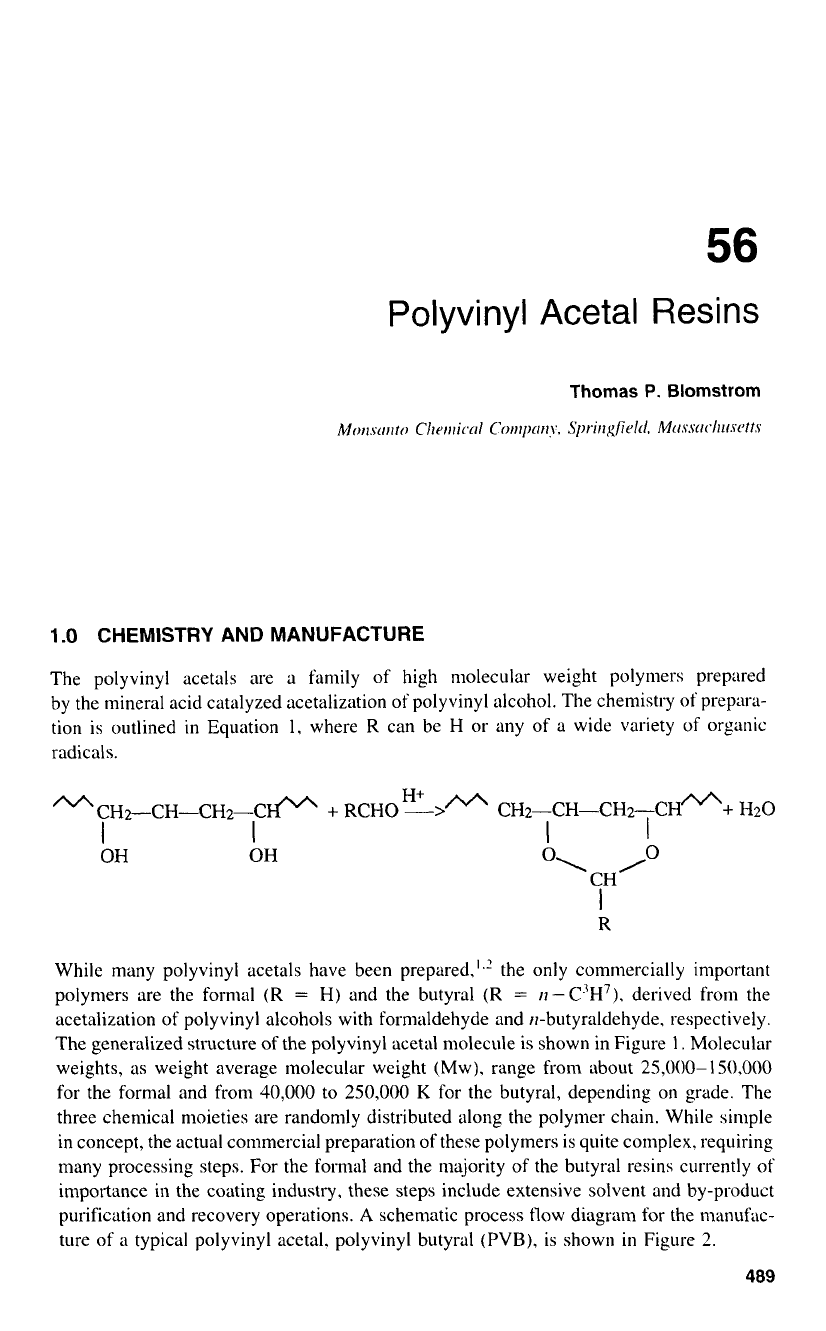
Polyvinyl
Acetal
Resins
1
.O
CHEMISTRY AND MANUFACTURE
The polyvinyl acetals are a family
of
high molecular weight polymers prepared
by the mineral acid catalyzed acetalization
of
polyvinyl alcohol. The chemistry
of
prepara-
tion is outlined
in
Equation
I.
where
R
can be
H
or any
of
a wide variety
of
organic
radicals.
M
CH2-CH-CH2-Ce
+
RCHO CH2-CH-CH2-CH'+ H20
I
I
I
I
OH OH
R
While many polyvinyl acetals have been prepared.',' the only commercially important
polymers are the formal
(R
=
H)
and the butyral
(R
=
rI
-(?H7),
derived from the
acetalization
of
polyvinyl alcohols with formaldehyde and rl-butyraldehyde, respectively.
The generalized structure
of
the polyvinyl acetal molecule is shown in Figure
1.
Molecular
weights, as weight average molecular weight
(MW).
range from about 25,000-150,000
for the formal and from
40,000
to 250,000
K
for the butyral, depending on grade. The
three chemical moieties are randomly distributed along the polymer chain. While simple
in concept, the actual commercial preparation
of
these polymers
is
quite complex, requiring
many processing steps. For the formal and the majority
of
the butyral resins currently
of
importance
in
the coating industry. these steps include extensive solvent and by-product
purification and recovery operations.
A
schematic process flow diagram for the manufac-
ture
of
a typical polyvinyl acetal. polyvinyl butyral
(PVB),
is shown
in
Figure 2.
489
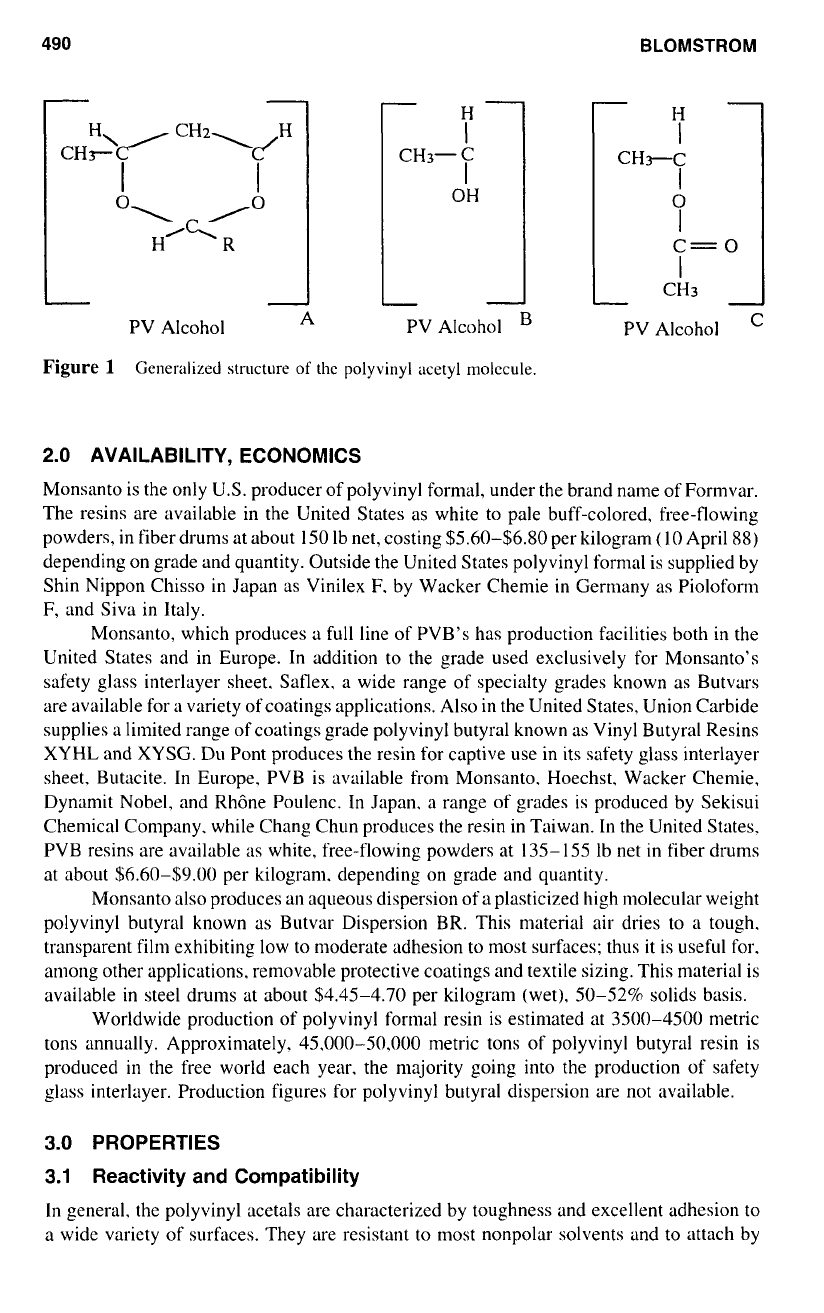
490
BLOMSTROM
PV Alcohol
1
A
PV Alcohol
B
-
-
H
CH3-C
I
I
0
I
c=
0
l
CH3
-
-
PV Alcohol
C
Figure
1
Generalized
structure
of
the
polyvinyl acetyl molecule.
2.0
AVAILABILITY, ECONOMICS
Monsanto is the only U.S. producer of polyvinyl formal, under the brand name of Formvar.
The resins are available in the United States as white to pale buff-colored. free-flowing
powders, in fiber drums at about
150
lb net, costing
$5.60-$6.80
per kilogram
(10
April
88)
depending
on
grade and quantity. Outside the United States polyvinyl formal is supplied by
Shin Nippon Chisso in Japan as Vinilex
F,
by Wacker Chemie
in
Germany as Pioloform
F,
and Siva in Italy.
Monsanto, which produces
;I
full
line of PVB's has production facilities both in the
United States and in Europe. In addition to the grade used exclusively for Monsanto's
safety glass interlayer sheet. Saflex. a wide range of specialty grades known as Butvars
are available for
a
variety ofcoatings applications. Also in the United States, Union Carbide
supplies a limited range of coatings grade polyvinyl butyral known as Vinyl Butyral Resins
XYHL and XYSG.
DU
Pont produces the resin for captive use in its safety glass interlayer
sheet, Butacite. In Europe, PVB is available from Monsanto. Hoechst, Wacker Chemie,
Dynamit Nobel, and Rhbne Poulenc. In Japan. a range of grades is produced by Sekisui
Chemical Company. while Chang Chun produces the resin in Taiwan.
In
the United States.
PVB resins are available
as
white, free-flowing powders at 135-
155
lb net
in
fiber drums
at about
$6.60-$9.00
per kilogram. depending on grade and quantity.
Monsanto also produces an aqueous dispersion ofa plasticized high molecular weight
polyvinyl butyral known as Butvar Dispersion
BR.
This material air dries to
a
tough.
transparent film exhibiting low
to
moderate adhesion
to
most surfaces; thus it is useful for,
among other applications. removable protective coatings and textile sizing. This material is
available
in
steel drums at about $4.45-4.70 per kilogram (wet),
50-52%
solids basis.
Worldwide production of polyvinyl formal resin is estimated at 3500-4500 metric
tons annually. Approximately. 45,000-50,000 metric tons
of
polyvinyl butyral resin is
produced
in
the free world each year. the majority going into the production of safety
glass interlayer. Production figures for polyvinyl butyral dispersion are not available.
3.0
PROPERTIES
3.1
Reactivity and Compatibility
In
general. the polyvinyl acetals are characterized by toughness and excellent adhesion
to
a wide variety
of
surfaces. They are resistant
to
most nonpolar solvents and
to
attach by
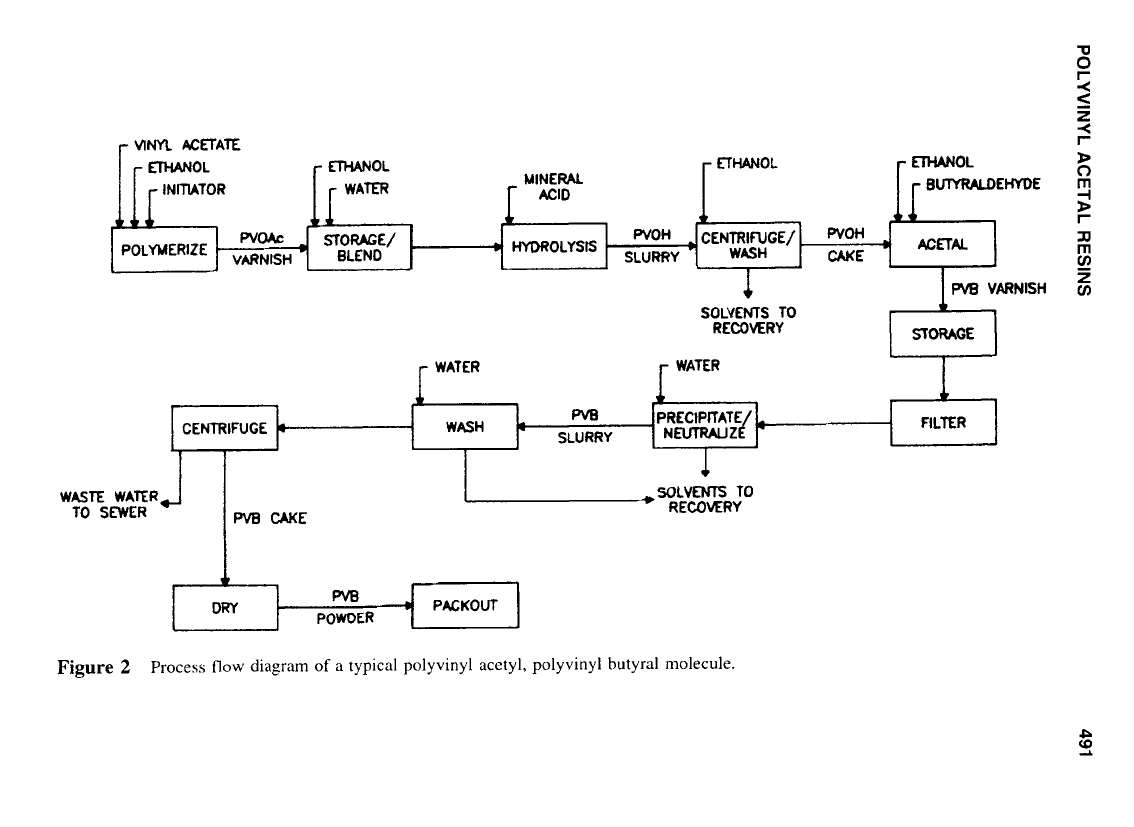
POLYVINYL ACETAL RESINS
491
a
W
c
S
4
1'
